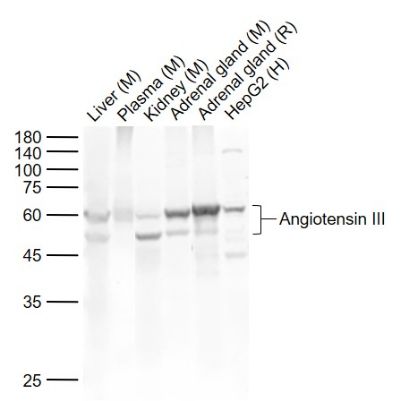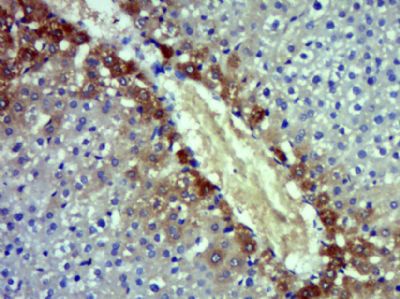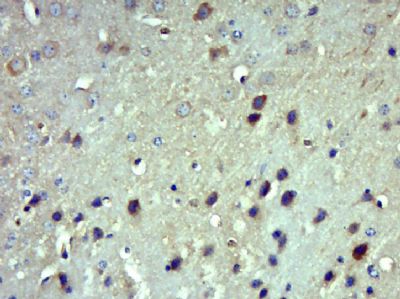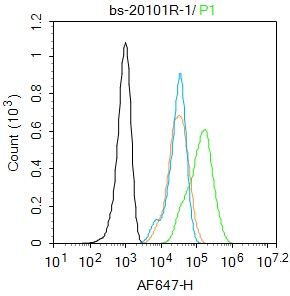上海细胞库
人源细胞系| 稳转细胞系| 基因敲除株| 基因点突变细胞株| 基因过表达细胞株| 重组细胞系| 猪的细胞系| 马细胞系| 兔的细胞系| 犬的细胞系| 山羊的细胞系| 鱼的细胞系| 猴的细胞系| 仓鼠的细胞系| 狗的细胞系| 牛的细胞| 大鼠细胞系| 小鼠细胞系| 其他细胞系|

| 规格 | 价格 | 库存 |
|---|---|---|
| 100ul | ¥ 1680 | 200 |
| 200ul | ¥ 2480 | 200 |
| 中文名称 | 血管紧张素III抗体 |
| 别 名 | ANGT_HUMAN; Angiotensin-1; Angiotensin I; Ang I; Angiotensin-2; Angiotensin II; Ang II; Ang III; Angiotensin-3; Angiotensin III; Angiotensin3; Angiotensin 3; Angiotensin-4; Angiotensin 1-4; Angiotensin 1-5; Angiotensin 1-7; Angiotensin 1-8; Angiotensin 2-8; Angiotensin 3-8; Angiotensin 1-9; Angiotensin 1-10; Angiotensinogen; Serpin A8; Angiotensin IV; Ang IV; ANHU; Des-Asp[1]-angiotensin II; SERPINA8. |
| 研究领域 | 心血管 免疫学 信号转导 内分泌病 脂蛋白 新陈代谢 |
| 抗体来源 | Rabbit |
| 克隆类型 | Polyclonal |
| 交叉反应 | Human, Mouse, Rat, (predicted: Horse, ) |
| 产品应用 | WB=1:500-2000 ELISA=1:500-1000 IHC-P=1:100-500 IHC-F=1:100-500 Flow-Cyt=1ug/Test ICC=1:100-500 IF=1:100-500 (石蜡切片需做抗原修复) not yet tested in other applications. optimal dilutions/concentrations should be determined by the end user. |
| 分 子 量 | 1/50kDa |
| 细胞定位 | 分泌型蛋白 |
| 性 状 | Liquid |
| 浓 度 | 1mg/ml |
| 免 疫 原 | KLH conjugated synthetic peptide of human Angiotensin III (RVYIHPF): |
| 亚 型 | IgG |
| 纯化方法 | affinity purified by Protein A |
| 储 存 液 | 0.01M TBS(pH7.4) with 1% BSA, 0.03% Proclin300 and 50% Glycerol. |
| 保存条件 | Shipped at 4℃. Store at -20 °C for one year. Avoid repeated freeze/thaw cycles. |
| PubMed | PubMed |
| 产品介绍 | Angiotensin III is an eptapeptide drived from cleavage of full length angiotensin (AGT). AGT is a polypeptide vasopressor hormone formed by the catalytic action of renin, which is released mainly by the kidneys in response to low blood volume or low sodium content in the body. The juxtaglomerular cells release renin when juxtaglomerular apparatus decreases in the kidneys. Renin (called angiotensinogenase) is an enzyme of the hydrolase class that catalyzes cleavage of the leucine leucine bond in angiotensinogen (a serum globulin) to generate angiotensin I in the liver. Angiotensin I acts mainly as a precursor to angiotensin II, which is a vasopressor and stimulator of aldosterone secretion by the adrenal cortex, and also functions as a neurotransmitter. Angiotensin III (heptapeptide) is a degradation product of angiotensin II, and has less vasopressor activity than the parent compound. However, Angiotensin III does stimulate aldosterone release. Function: Essential component of the renin-angiotensin system (RAS), a potent regulator of blood pressure, body fluid and electrolyte homeostasis. Angiotensin-2: acts directly on vascular smooth muscle as a potent vasoconstrictor, affects cardiac contractility and heart rate through its action on the sympathetic nervous system, and alters renal sodium and water absorption through its ability to stimulate the zona glomerulosa cells of the adrenal cortex to synthesize and secrete aldosterone. Angiotensin-3: stimulates aldosterone release. Angiotensin 1-7: is a ligand for the G-protein coupled receptor MAS1. Has vasodilator and antidiuretic effects. Has an antithrombotic effect that involves MAS1-mediated release of nitric oxide from platelets. Subunit: During pregnancy, exists as a disulfide-linked 2:2 heterotetramer with the proform of PRG2 and as a complex (probably a 2:2:2 heterohexamer) with pro-PRG2 and C3dg. Subcellular Location: Secreted. Tissue Specificity: Expressed by the liver and secreted in plasma. Post-translational modifications: Beta-decarboxylation of Asp-34 in angiotensin-2, by mononuclear leukocytes produces alanine. The resulting peptide form, angiotensin-A, has the same affinity for the AT1 receptor as angiotensin-2, but a higher affinity for the AT2 receptor. In response to low blood pressure, the enzyme renin/REN cleaves angiotensinogen to produce angiotensin-1. Angiotensin-1 is a substrate of ACE (angiotensin converting enzyme) that removes a dipeptide to yield the physiologically active peptide angiotensin-2. Angiotensin-1 and angiotensin-2 can be further processed to generate angiotensin-3, angiotensin-4. Angiotensin 1-9 is cleaved from angiotensin-1 by ACE2 and can be further processed by ACE to produce angiotensin 1-7, angiotensin 1-5 and angiotensin 1-4. Angiotensin 1-7 has also been proposed to be cleaved from angiotensin-2 by ACE2 or from angiotensin-1 by MME (neprilysin). The disulfide bond is labile. Angiotensinogen is present in the circulation in a near 40:60 ratio with the oxidized disulfide-bonded form, which preferentially interacts with receptor-bound renin. DISEASE: Essential hypertension (EHT) [MIM:145500]: A condition in which blood pressure is consistently higher than normal with no identifiable cause. Note=Disease susceptibility is associated with variations affecting the gene represented in this entry. Renal tubular dysgenesis (RTD) [MIM:267430]: Autosomal recessive severe disorder of renal tubular development characterized by persistent fetal anuria and perinatal death, probably due to pulmonary hypoplasia from early-onset oligohydramnios (the Potter phenotype). Note=The disease is caused by mutations affecting the gene represented in this entry. Similarity: Belongs to the serpin family. SWISS: P01019 Gene ID: 183 Database links: Entrez Gene: 183 Human Omim: 106150 Human SwissProt: P01019 Human Unigene: 19383 Human Important Note: This product as supplied is intended for research use only, not for use in human, therapeutic or diagnostic applications. |
| 产品图片 |  Sample: Sample:Lane 1: Liver (Mouse) Lysate at 40 ug Lane 2: Plasma (Mouse) at 20 ug Lane 3: Kidney (Mouse) Lysate at 40 ug Lane 4: Adrenal gland (Mouse) Lysate at 40 ug Lane 5: Adrenal gland (Rat) Lysate at 40 ug Lane 6: HepG2 (Human) Cell Lysate at 30 ug Primary: Anti-Angiotensin III (bs-20101R) at 1/1000 dilution Secondary: IRDye800CW Goat Anti-Rabbit IgG at 1/20000 dilution Predicted band size: 52/60 kD Observed band size: 52/60 kD  Paraformaldehyde-fixed, paraffin embedded (Rat liver); Antigen retrieval by boiling in sodium citrate buffer (pH6.0) for 15min; Block endogenous peroxidase by 3% hydrogen peroxide for 20 minutes; Blocking buffer (normal goat serum) at 37°C for 30min; Antibody incubation with (Angiotensin III) Polyclonal Antibody, Unconjugated (bs-20101R) at 1:400 overnight at 4°C, followed by operating according to SP Kit(Rabbit) (sp-0023) instructionsand DAB staining. Paraformaldehyde-fixed, paraffin embedded (Rat liver); Antigen retrieval by boiling in sodium citrate buffer (pH6.0) for 15min; Block endogenous peroxidase by 3% hydrogen peroxide for 20 minutes; Blocking buffer (normal goat serum) at 37°C for 30min; Antibody incubation with (Angiotensin III) Polyclonal Antibody, Unconjugated (bs-20101R) at 1:400 overnight at 4°C, followed by operating according to SP Kit(Rabbit) (sp-0023) instructionsand DAB staining. Paraformaldehyde-fixed, paraffin embedded (Mouse brain); Antigen retrieval by boiling in sodium citrate buffer (pH6.0) for 15min; Block endogenous peroxidase by 3% hydrogen peroxide for 20 minutes; Blocking buffer (normal goat serum) at 37°C for 30min; Antibody incubation with (Angiotensin III) Polyclonal Antibody, Unconjugated (bs-20101R) at 1:400 overnight at 4°C, followed by operating according to SP Kit(Rabbit) (sp-0023) instructionsand DAB staining. Paraformaldehyde-fixed, paraffin embedded (Mouse brain); Antigen retrieval by boiling in sodium citrate buffer (pH6.0) for 15min; Block endogenous peroxidase by 3% hydrogen peroxide for 20 minutes; Blocking buffer (normal goat serum) at 37°C for 30min; Antibody incubation with (Angiotensin III) Polyclonal Antibody, Unconjugated (bs-20101R) at 1:400 overnight at 4°C, followed by operating according to SP Kit(Rabbit) (sp-0023) instructionsand DAB staining. Blank control: HepG2. Blank control: HepG2.Primary Antibody (green line): Rabbit Anti-Angiotensin III antibody (bs-20101R) Dilution: 1μg /10^6 cells; Isotype Control Antibody (orange line): Rabbit IgG . Secondary Antibody : Goat anti-rabbit IgG-AF647 Dilution: 1μg /test. Protocol The cells were fixed with 4% PFA (10min at room temperature)and then permeabilized with 0.1% PBST for 20 min at room temperature. The cells were then incubated in 5%BSA to block non-specific protein-protein interactions for 30 min at room temperature .Cells stained with Primary Antibody for 30 min at room temperature. The secondary antibody used for 40 min at room temperature. Acquisition of 20,000 events was performed. |